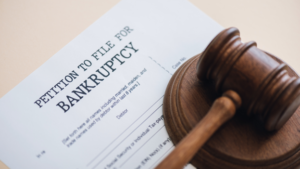How to File for Bankruptcy in Texas
Finding the debt relief option that’s right for you can be daunting. Speaking with a seasoned bankruptcy attorney can help you discover how to file for bankruptcy and which options will best suit your circumstances and financial goals. At Leinart Law Firm, our Dallas bankruptcy lawyers have more than 15 years of experience serving clients throughout north Texas. Understanding the different types of bankruptcies and how they work can help you make well-informed decisions that address your specific needs.
Steps to Take When Filing for Bankruptcy

Even if you believe filing for bankruptcy is the right choice, how do you know which one to file? There are several bankruptcy options, including Chapter 13, Chapter 7 and Chapter 11, or business bankruptcy. Following these steps can help you understand how to file for bankruptcy and the benefits and drawbacks of each type.
1. Gather Financial Information
Although you’ll have to fill out formal paperwork when filing for bankruptcy, taking a comprehensive look at your financial situation before you make any decisions is crucial. Making a list of all your property, assets, income, expenses, liabilities and debts can help you and your attorney determine which debt relief solutions may work best for you. Debts like student loans, child support, alimony, and some taxes are typically non-dischargeable, but it’s important to include them so your bankruptcy lawyer can get a clear picture of your finances.
2. Schedule a Consultation with a Texas Bankruptcy Attorney
Each state has its own bankruptcy laws and exemptions, so it’s important to choose a lawyer who is well-versed in both state and federal bankruptcy law. Our debt relief lawyers at Leinart Law Firm do a comprehensive evaluation of your financial circumstances and advise you of all options that may be available to you. Your initial consultation is free, and we offer straightforward advice you can trust regardless of whether you decide to proceed with your bankruptcy case.
3. Determine If Bankruptcy Is Right for You
Struggling with debt doesn’t mean that filing for bankruptcy is your only option. Depending on the amount and type of debt you’re trying to manage, other options such as credit repair or consumer credit counseling may be more appropriate. For example, if you’re overwhelmed with credit card debt but have no problem paying your mortgage or car loan, an attorney may be able to negotiate a settlement agreement with the credit card companies for less than you owe.
If we determine that filing Chapter 7 or Chapter 13 bankruptcy is the most practical solution for your situation, we help you understand your rights and responsibilities, assist you with filing and guide you through the process every step of the way.
4. Choose the Right Type of Bankruptcy
Bankruptcy laws are complex. There are many issues to consider, and it’s important that you fully understand the benefits and limitations of the different types of bankruptcies. For example, if you want to file for bankruptcy to stop home foreclosure and get current with your mortgage payments, filing for Chapter 13 bankruptcy may be appropriate. If you don’t own your home but need to get rid of overwhelming credit card or medical debt, filing for Chapter 7 bankruptcy can help wipe out your debt and give you a clean financial slate.
Chapter 13 Bankruptcy
Also called a wage earner’s plan, Chapter 13 bankruptcy allows consumers and some businesses to develop a payment plan to catch up on secured debts (house, car etc) over a period of three to five years and to eliminate (for most people) or greatly reduce unsecured debt (credit cards, medical bills etc). It can also lower your interest rate on certain secured debts and even allow you to pay the current value of your car if you are upside down.
Chapter 7 Bankruptcy
Unlike its counterparts, Chapter 7 bankruptcy does not entail the filing of a payment plan. Many people are leery of Chapter 7 bankruptcy because they think the trustee will sell all of their property. In most cases, no property has to be given up or sold. To qualify for Chapter 7, you may be subject to a means test to determine whether you have the income or resources to repay some or all of your debt.
Filing for either type of bankruptcy puts an automatic stay on your debts so creditors cannot continue collection actions against you. Each type of bankruptcy has its own pros and cons. Understanding how they may work in your situation is critical to protecting your future financial health. The last thing you want is to file for bankruptcy and later find out that some of your debts could have been dischargeable or included in a Chapter 13 repayment plan. Our Texas bankruptcy attorneys can help you avoid common pitfalls and advise you of which type of bankruptcy will be of the most benefit to you.
5. Get Credit Counseling
Regardless of the type of bankruptcy you file, federal law requires that debtors receive credit counseling within 180 days before filing. A credit counselor will review your finances, help you create a budget and discuss possible alternatives to bankruptcy with you. Credit counseling sessions usually only last an hour or two and can be done in person, online or over the phone. When you’ve completed credit counseling, you’ll receive a certificate that must be provided with your bankruptcy filing. Our Fort Worth and Dallas bankruptcy attorneys can recommend approved credit counseling providers in Texas.
6. Prepare Your Bankruptcy Petition
Filing for bankruptcy under Chapter 7 or Chapter 13 takes careful preparation. Inaccuracies, omissions and mistakes can affect your rights and slow the process. A specific understanding of Texas state exemptions is necessary to determine if any assets are not subject to bankruptcy, including any real estate, cars, money and certain personal belongings. Our Dallas bankruptcy lawyers can assist you with preparing and filing your petition. Some courts require local forms. We ensure that the proper forms are accurately completed and filed in a timely manner.
You may need to file an emergency bankruptcy petition if creditors are threatening to seize your assets or you have been served with a lawsuit. In these types of cases, having an experienced bankruptcy lawyer is even more important, as you still need to take a credit counseling course and submit certain forms. Typically, you have 14 days to submit additional required forms for your petition, or your case may be dismissed.
7. File Your Bankruptcy Petition
You must file your bankruptcy petition with the federal bankruptcy court. Texas has four federal judicial districts, and each district has multiple divisions, so it’s important to make sure you file with the right court. After your petition has been completed and filed and your filing fees are paid, notice of the bankruptcy filing will be sent to all of your creditors. This informs them that you have filed for protection under the bankruptcy code and should stop any collection, repossession or foreclosure efforts. A judge will review your petition and determine whether you are eligible to declare bankruptcy. Once the court grants the petition, your case will be assigned to a court trustee.
8. Attend a Meeting of Creditors
Although it may sound intimidating, a meeting of creditors is usually only a meeting with the bankruptcy trustee in a conference room. Although creditors are entitled to attend, they usually don’t. The bankruptcy trustee will review the accuracy of the information filed with the court. It’s important to review your bankruptcy petition with your attorney before the meeting to ensure no required information was omitted and that there are no discrepancies. If you notice that anything is incorrect at any time, make sure to bring it to the attention of your attorney or the bankruptcy trustee.
Bring a state ID or passport for identification, your Social Security card or other proof of your SSN, such as a W-2 form, and any documents relevant to any financial change you may have had since filing your petition. Your bankruptcy lawyer from Leinart Law Firm will bring the bankruptcy paperwork and inform you of anything else you may need to bring.
In most cases, a meeting of creditors takes 10 minutes or less. The trustee will swear you in, ask some common questions and inquire about any matters that may need more explanation. Our bankruptcy attorneys will prepare you for this meeting and let you know what to expect.
Depending on the type of bankruptcy you file, typical questions may include:
- Did you review your bankruptcy petition and schedules before filing them with the court?
- Is everything included in your petition true and correct to the best of your knowledge?
- Do your bankruptcy forms include all your assets and creditors?
- Have you filed for bankruptcy before? If so, when?
- Has anything changed since you filed for bankruptcy?
- Do you have any obligations such as alimony or child support?
The trustee may also ask you about specific assets like real estate, vehicles, investment accounts and any money you may receive in the future due to a lawsuit settlement, inheritance or life insurance. They may also inquire about property or cash you’ve sold or given away in the last year, your job and your income. It’s important to be honest when answering these questions, as you will be under oath. Bankruptcy trustees know that honest mistakes and omissions happen but may not be so understanding if you deliberately mislead them.
9. Take a Debtor Education Course
Before the court will grant your bankruptcy discharge, you must complete a debtor education course from an approved provider. The purpose of this course is to help you learn how to manage your finances better and may include information about budgeting, interest rates, using credit cards and how you can begin to rebuild your credit for a successful financial future.
After the course is finished, you’ll file a form 423 and certificate showing that you completed the course. If you file for Chapter 7 bankruptcy, you must submit your certificate from this course no later than 45 days after the date of your meeting of creditors. You may even take the course before the meeting if you wish.
If you file Chapter 13 bankruptcy, you have until the date you make your last payment to submit your certificate from your debtor education course. However, taking the course early on can help you learn budgeting and money management skills that can benefit you throughout the repayment period.
10. Get a Fresh Financial Start
If there are no issues with your bankruptcy, your debts will be discharged in Chapter 7 or you will begin to repay your debts according to the terms of your Chapter 13 plan. If you have any debts that were not eligible to be included in your bankruptcy, make sure to speak to those creditors to work out a payment plan or settlement agreement.
Our bankruptcy attorneys at Leinart Law Firm love to see clients thrive after the heavy weight of debt is lifted off their shoulders. We can provide recommendations about how to deal with any non-dischargeable debts you may still owe and assist you with any settlement negotiations.
Explore Your Bankruptcy Options
At Leinart Law Firm, our overriding goal is to provide you with top-notch legal advice and help you obtain financial freedom. We utilize bankruptcy laws to help you stop collections, harassment, foreclosures, repossessions and wage garnishments. Our compassionate, competent team knows that the burden of insurmountable debt can be overwhelming. We’re here to help you find relief, understand how to file for bankruptcy, guide you through the process and represent your interests at all bankruptcy proceedings.
Prompt Communication and Personal Attention

At Leinart Law firm, we believe everyone should be treated with dignity and respect. You can rest assured that we will do everything we can to relieve the anxiety and stress you may be feeling about your financial situation. We care about our clients and understand that you’re putting your trust in us. Our attorneys return phone calls as quickly as possible and make it a priority to address your concerns in a timely manner. Unlike many Texas bankruptcy law firms, you’ll meet with a bankruptcy lawyer on your very first visit. Our bankruptcy lawyers in Dallas and Fort Worth are dedicated to providing the responsive, personalized attention you deserve.
Contact Our Bankruptcy Attorneys to Schedule a Free Case Evaluation
If you’re struggling with crushing debt, you don’t have to go it alone. Our bankruptcy attorneys at Leinart Law Firm are here to help you get your finances back on track and find a fresh start. To schedule a free consultation, call us in Dallas at 469-232-3328 or Fort Worth at 817-426-3328 or email us today. You can also use the convenient chat feature or contact form on our website to get in touch. We proudly serve clients in Dallas, Fort Worth, Plano and throughout North Texas
How Our Law Firm Helps You with Bankruptcy
Schedule a FREE, no-obligation consultation and evaluation today.



